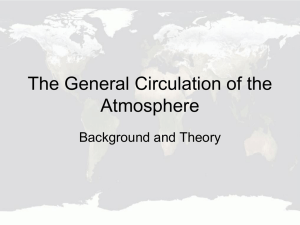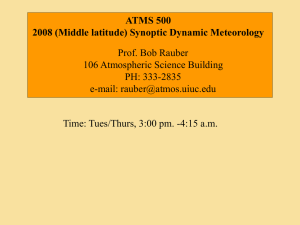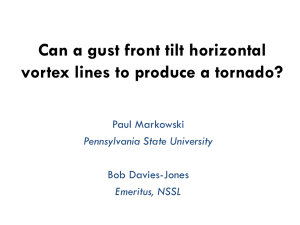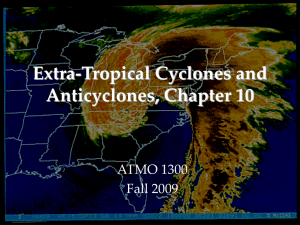Hamiltonian Fluid Mechanics
advertisement
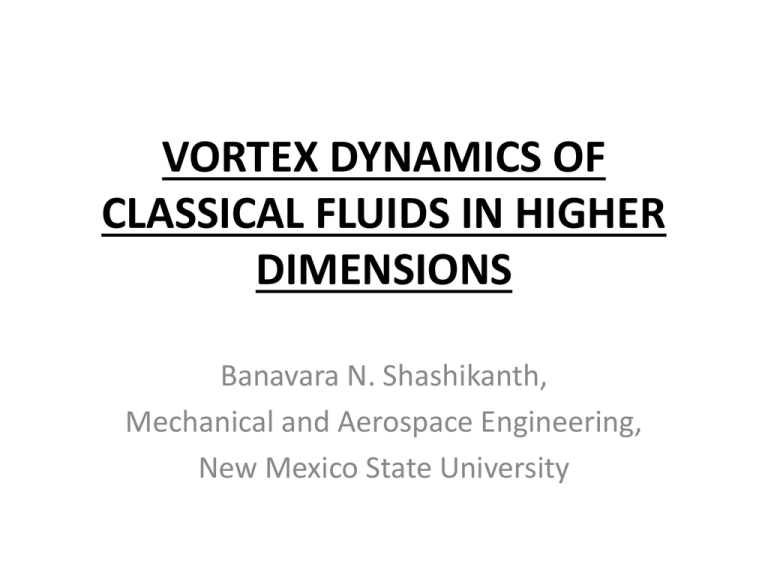
VORTEX DYNAMICS OF
CLASSICAL FLUIDS IN HIGHER
DIMENSIONS
Banavara N. Shashikanth,
Mechanical and Aerospace Engineering,
New Mexico State University
Outline
• Recall some basic facts of
the vorticity two-form
surfaces of singular vorticity in R2 (point vortices) and in R3
(vortex filaments)
the local induction approximation (LIA) and the
self-induced velocity of filaments
• Surfaces of singular vorticity in R4 ---vortex membranes
• Self-induced velocity field of a membrane using LIA
• Dynamics of ! ^ ! and an application to Ertel’s theorem
Vorticity of ideal fluids in Rn
• For n = 2; 3 vorticity is commonly identified with a
function, vector field, respectively, and defined as
! vec = r £ v
• Strictly speaking, vorticity is a two-form (Arnold (‘66))
! = dv[
v [ is the velocity one-form,
d is the exterior derivative
• By definition, vorticity is a closed two-form i.e. d ! = 0
Vorticity of ideal fluids in Rn
• For n = 2; 3 the Hodge star operator allows the
identification with a function, vector field, respectively
• For n ¸ 4 , vorticity must be considered as a two-form
In Cartesian coordinates on Rn , vorticity has n( n ¡ 1) =2
components. For n = 4,
! = ! 12 dx 1 ^ dx 2 + ! 13 dx 1 ^ dx 3 + ! 14 dx 1 ^ dx 4
+ ! 23 dx 2 ^ dx 3 + ! 24 dx 2 ^ dx 4 + ! 34 dx 3 ^ dx 4
Vorticity of ideal fluids in Rn
• Lie-Poisson evolution of vorticity of an ideal fluid in Rn
(more generally, ideal fluid on an n-dimensional manifold M )
Arnold (`66), Marsden and Weinstein (`83), Morrison (`82)
• The vorticity two-form is an element of
---dual of the Lie
algebra of divergence-free velocity fields in Rn
Singular distributions of vorticity
• Preservation of coadjoint orbits : A vorticity two-form,
evolving by Lie-Poisson dynamics, remains on the same
coadjoint orbit of
(Marsden and Weinstein (‘83))
• Singular vorticity distributions: in the context of classical
fluids, can be viewed as idealized models of coherent
vorticity. Examples of singular vorticity distributions:
----point vortices in R2 ,
----vortex filaments in R3
• Point vortex and vortex filament models are popular with
engineers, mathematicians and physicists!
Singular distributions of vorticity
point vortices in
phase space
Poisson brackets
Singular distributions of vorticity
vortex filaments in
1
phase space: space of images of N smooth maps ' : S !
(modulo re-parametrizations),
infinite-dimensional space
Poisson brackets
f F; Gg
XN
=
j=1
1
¡j
¿
I
Cj
±F
±G
£
;tj
±Cj
±Cj
À
dsj
(functional derivatives identified
with normal vector fields on curves)
R3
Singular distributions of vorticity
• Marsden and Weinstein (’83) : The Poisson
brackets/symplectic structures for both models are obtained
from the formula for the symplectic structure - of coadjoint
orbits (c.o.) of vorticity two-forms !
where
are divergence-free velocity fields.
• M & W derived this from the general Kirillov-Kostant-Soureau
formula for the symplectic structure of coadjoint orbits
Singular distributions of vorticity
• M & W (`83) showed that this recovers the classical N point
vortex symplectic structure:
XN
!
p:v : (r )
=
¡ j ±(r ¡ r j )dx ^ dy;
j=1
Z
)
XN
!
p:v :
(u; v) ¹ =
R2
giving the symplectic form
point vortex phase space
¡ j dx ^ dy (u(r j ); v(r j ))
j=1
P
N
j=1
¡ j dx j ^ dyj on the
Singular distributions of vorticity
• M & W (`83) also presented a symplectic structure for N
vortex filaments:
XN
!
¯l (r )
=
¡ j ±(r ¡ r (sj ))dn 1;j ^ dn 2;j (sj );
j=1
Z
)
!
R3
I
XN
¯l
(u; v) ¹ =
¡j
j=1
dn 1;j ^ dn 2;j (sj ) (u(sj ); v(sj )) dsj
Cj
I
XN
giving the symplectic form
j=1
¡j
dn 1;j ^ dn 2;j (sj ) ( ; ) dsj
Cj
on the phase space of vortex filaments. This form acts on
filament normal vector fields
Singular distributions of vorticity
n 1;j
n 2;j
tj
Cj
Singular distributions of vorticity
• General geometric features of point vortices and vortex
filaments:
They are co-dimension 2 surfaces
The vorticity two-form ! acts on planes that intersect these
surfaces transversally. More precisely, the two-form ! is
perpendicular to these surfaces.
Equivalently, using the Hodge star operator in Rn , the n-2
form ?! is tangent to these surfaces
Singular distributions of vorticity
• Minimum dimension of the surfaces
= the degree of the form ?!
= n-2
• Can we have singular distributions that do not satisfy the
above?
For example, point vortices in R3 or `vortons’
(Novikov (`83), Leonard (`85)). Here, each point is
also assigned a (time-varying) direction vector and
the `vorticity’ two-form acts on the single plane to which it is
normal. This `vorticity’ two-form is not closed i.e. d ! 6
= 0!
Singular distributions of vorticity
• Moving on to R4
• We consider two-dimensional surfaces/manifolds to which
?! ---now, a two-form---is tangent. We term these
surfaces vortex membranes
• At each point of such a (co-dimension 2) surface § there
exists a plane of normals
Singular distributions of vorticity
• The vorticity two-form ! § for a membrane is
! § ( m) = ¡ ±( m ¡ p) dn 1 ^ dn 2 ( p) ;
m 2 R4 ; p 2 §
where dn 1 ^ dn 2 ( p) is an area form in the plane
of normals at p
n1
p
t2
n2
t1
§
Dynamics of singular vorticity
• An important notion in the dynamics of singular vorticity is
the self-induced velocity field
• Recall,
point vortices in
---- no self-induced velocity field
vortex filaments in
---- infinite self-induced velocity field!
• Two ways of obtaining the expression for the self-induced
velocity of a filament in
---- invert the kinematic relation r 2 v = ¡ r £ ! vec
---- use the M & W symplectic structure and the
kinetic energy Hamiltonian
Dynamics of singular vorticity
• Both lead to the Biot-Savart integral for filaments
¡
vSI (q(~
s)) =
4¼
I
t(s) £ (l(~
s) ¡ l(s)) ds
C
jl(~
s) ¡ l(s)j
3
;
q(~
s) 2 C
The integral is divergent due to the integrand singularity at s = s
~
• The velocity has a logarithmic singularity and is infinite in the
binormal direction
curvature
¡ ¡
vSI (q(~
s)) = lim log ²
· (~
s) b( s~) + O(1) t erms;
²! 0
4¼
(² = j s~ ¡ s j)
Dynamics of singular vorticity
• To obtain a finite vSI , the integral has to be regularized
• One commonly used regularization method is the Local
Induction Approximation (LIA) (DaRios (‘06), Arms and Hama (‘65))
• The LIA is based on the observation that the leading order
contribution to vSI is due to a local neighborhood of s~.
Non-local portions of the filament contribute O(1) terms only
• Treating ² as a small but fixed `cut-off’ parameter, the
regularized velocity, according to the LIA, is
¡ ¡
vSI ;r eg (q(~
s)) = log ²
· (~
s) b(~
s)
4¼
Dynamics of singular vorticity
• This leads to the famous filament equation (using the SerretFrenet equations for a curve in )
@C(s; t)
@C(s; t) @2 C(s; t)
=
£
@t
@s
@s2
where C : S1 £ R !
R3 or C : R £ R ! R3
µ Zs
¶
¿(u) du
• Hasimoto’s transformation Ã(s) = · (s) exp i
0
gives the non-linear Schrödinger equation (NLS)!
@Ã
@2 Ã 1
2
¡ i
=
+
j
Ã
j
Ã; Ã : R £ R ! C
2
@t
@s
2
Dynamics of singular vorticity
• NLS is an integrable Hamiltonian system.
• The precise relation between the M & W Poisson structure
of the filament equation and the Poisson structure of the
NLS was clarified by Langer and Perline (`91).
Dynamics of singular vorticity
• Returning to R4 and vortex membranes
• Main objective: obtain an expression for the (regularized)
self-induced velocity field of a membrane
• Generalize the Biot-Savart expression as follows:
first, generalize the kinematic relation r 2 v = ¡ r £ !
±dv[ = ±! ;
where ± : - k + 1 (R4 ) ! - k (R4 ) is the
co-differential operator defined as ± = ¡ ? d?
vec
to
Dynamics of singular vorticity
In the standard basis f ei g, the equation is equivalent to
the Poisson equation
r 2 vi = f i ;
i = 1; ¢¢¢; 4
where f i := ±! (ei )
Elliptic theory, Green’s functions and integration by parts
gives
Z
v( m)
~ = ¡
(?(d m G(m; m)
~ ^ ?! )) ] ¹ m ; m; m
~ 2 R4
R4
¡
2
2
¢¡
where G = ¡ ¼ (j r (m) ¡ r ( m)
~ j )
Green’s function of the Laplacian in R4
1
is the
Dynamics of singular vorticity
The above is the generalization of the Biot-Savart formula to R4
and gives the velocity at any field point m
~ 2 R4 due to any !
• Substituting ! § gives the expression for the self-induced
velocity of a membrane
Z
vSI (p) = ¡
((r G ¢n 2 )n1 ¡ (r G ¢n1 )n2 )ds1 ^ ds2 ; m; p 2 §
§
where (n1 ; n2 ; t 1 ; t 2 ) is a moving orthonormal frame with
t 1; t 2 2 Tm § ; n1; n2 2 Nm and dsi (t j ) = ±i j
• As m ! p; vSI (p) blows up due to the integrand singularity
and the expression has to be regularized using LIA
Dynamics of singular vorticity
• LIA applied to a membrane
s1 ; s2 : arc ¡ lengt h paramet ers
s2
s1
p
s2 = f (s1 ; µ);
! s1 µ; as s1 ! 0
• Choose an (s1 ; µ) coordinate system as shown, with p at s1 = 0
• Series expand position vectors r (s1 ; µ) and moving frame
basis (n1 ; n2 ; t 1 ; t 2 )(s1 ; µ) for small s1 along `diameter’
curves (µ1 = constant)
Dynamics of singular vorticity
• At p(s1 = 0) there is a one-parameter family of tangent
vectors (n1(0); n2(0); t 1 (0; µ); t 2 (0; µ))
• Introducing the `cut-off’ parameter ² of LIA, obtain
vSI ;r eg (p)
¡ ¡
= 2 log ²
¼
Z
0
2¼ · µ
@n 2 (0)
t 1 (0; µ) ¢
@s1
¶
µ
n 1 (0) ¡
@n 1 (0)
t 1 (0; µ) ¢
@s1
¶
¸
n 2 (0) dµ
Dynamics of singular vorticity
• Another expression for vSI ;r eg (p) using the M&W coadjoint
orbit symplectic formula
• Consider P the phase space of membranes—the space of
images of maps (modulo re-parametrizations with the same
image) § : S2 ! R4 or § : R2 ! R4
• An element of Tp P can then be identified with a field of
normal vectors un on §
• The M&W
a symplectic structure on P
Z formula yields Z
!
R4
§
(u; v) ¹ = ¡
dn1 ^ dn 2 (un ; vn ) º
§
Dynamics of singular vorticity
• Kinetic energy of the fluid flow
Z
1
K :E : =
v[ ^ ?v[ ;
2 R4
Z
1
=
! ^ ?A [int egrat ion by part s]
2 R4
where the vector potential two-form A satisfies
d±A = ! ;
(±A = v[ ; dA = 0)
• This is again Poisson’s equation in each of the six components
of ! and A . For ! § , inversion by Green’s function gives
Z
1
4
A § (m) = ¡
º
;
m
2
R
;p2 §
p
2
2
§ ¼ (j r (m) ¡ r (p) j )
Dynamics of singular vorticity
• The kinetic energy of the flow due to a membrane
Z
¡
K :E : =
A § (m)º ; m 2 §
2 §
2 Z Z
¡
1
=
º p º m ; m; p 2 §
2
2
2 § § ¼ (j r (m) ¡ r (p) j )
• This is a functional on the membrane phase space P .
However, the integral is not convergent as m ! p
• Regularization by LIA gives the membrane Hamiltonian
Z
2
¡ ¡
K :E :r eg :=
log ²
º = : H (§ )
¼
§
Dynamics of singular vorticity
• The Hamiltonian, modulo constants, is the area functional.
Recall, the Hamiltonian (regularized K.E.) for a filament is the
length functional
• Using this Ham and the M&W symplectic structure, and taking
variational derivatives, obtain the Hamiltonian vector field
X H (p) ´ vSI ;r eg as
vSI ;r eg (p)
¡2
=
log(²)R ¡
¼
0
1
B @n 1
C
@
n
@
n
@
n
1
2
2
B
¢t 1 +
¢t 2 ;
¢t 1 +
¢t 2 C
(p)
¼=2 ¢@
A
@s
@s
@s
@s
| 1
{z 2 } | 1
{z 2 }
n 1 com p onent
n 2 com p onent
Dynamics of singular vorticity
• Note: in taking the variational derivatives, we use the
following chart—slightly different from the previous chart
s2
p
s1
• In summary, we have two expressions for vSI ;r eg (p) , both using
LIA. One directly from the (generalized) Biot-Savart integral,
the other from the Ham vector field of the kinetic energy
Dynamics of singular vorticity
• The final step is showing that each of these (modulo
constants) is equal to the mean curvature vector rotated by 90
degrees in the plane of normals
• Recall, that for a 2D surface ¾in R3, the second fundamental
form is defined as
S (V )(p) := ¡ hh(D n(p) ¢V ); V i i ;
V 2 Tp ¾; p 2 ¾
where n is the unit normal, and the mean curvature · as
1
· (p) = (S (t 1 ) + S (t 2 )) (p);
2
t 1 ; t 2 2 Tp ¾;
where (n; t 1 ; t 2 ) is an orthonormal frame
Dynamics of singular vorticity
• For a 2D surface § in R4, there is a second fundamental
form associated with each of the normal directions of the
moving frame (n1 ; n2 ; t 1 ; t 2 )
S 1 (V )(p) := ¡ hh(D n 1 (p) ¢V ); V i i ;
S 2 (V )(p) := ¡ hh(D n 2 (p) ¢V ); V i i ;
V 2 Tp § ;
• The mean curvature vector K(p)is then defined as
X2 1
K(p) =
(S i (t 1 ) + S i (t 2 )) (p)n i (p)
2
i= 1
Dynamics of singular vorticity
• And so, for the expression obtained using M&W formula
vSI ;r eg (p)
¡2
=
log(²)R ¡
¼
0
1
B @n 1
C
@n 1
@n 2
@n 2
B
¢t 1 +
¢t 2 ;
¢t 1 +
¢t 2 C
(p)
¼=2 ¢@
A
@s
@s
@s
@s
| 1
{z 2 } | 1
{z 2 }
n 1 com p onent
2¡ 2
= ¡
log(²)R ¡
¼
¼=2
¢K(p)
n 2 com p onent
Dynamics of singular vorticity
• Next, showing that
Z
2¼ · µ
1
2¼ 0
Z 2¼ · µ
1
2¼
0
¶¸
@n 2 (0)
= ¡ K(p) ¢n 2 (0)
@s1
¶¸
@n 1 (0)
t 1 (0; µ) ¢
dµ = ¡ K(p) ¢n 1 (0)
@s1
t 1 (0; µ) ¢
the expression obtained from the (generalized) Biot-Savart
law can also be written as
2¡ 2
vSI ;r eg (p) = ¡
log(²)R ¡
¼
¼=2
¢K(p)
The dynamics of the four-form ! ^ !
• In R2 and R3,
! ^ ! is identically zero
• Integral laws for ! ^ ! derived by Arnold and Khesin (‘98),
also discussed in papers on 4D Navier-Stokes turbulence, for
ex. Gotoh, Watanabe, Shiga and Nakano (2007)
• The evolution equation for
! ^ ! is
@(! ^ ! )
+ L v (! ^ ! ) = 0
@t
An application to Ertel’s theorem in R3
• Consider a divergence-free velocity field w in R3 and a
smooth function f : R3 ! R
• The vector field v := (w; f )is divergence-free in R4 . In
coordinates (x; y; z; o) ,
v[ = w1 (x; y; z)dx + w2 (x; y; z)dy + w3 (x; y; z)dz + f (x; y; z)do
• Euler’s equations for v (or v[ ) are Euler’s equations for w and
the passive advection equation for f , and
! ^ ! = ( !~vec ¢r f ) dx ^ dy ^ dz ^ do
where !~ = dw[
References
• B. N. Shashikanth (2012), Vortex dynamics in R4, Journal of
Mathematical Physics, vol. 53, 013103, 21 pages
• B. A. Khesin (2012): Symplectic Structures and Dynamics on
Vortex Membranes, Moscow Mathematical Journal, Vol. 12,
No. 2
Khesin generalizes these results to any Rn and also presents
a Hamiltonian formalism for vortex sheets
References
• S. Haller and C. Vizman (2003): Nonlinear Grassmannians as
coadjoint orbits, arXiv:math.DG/0305089, 13pp
Haller and Vizman—working in a purely geometric context—
show that the Hamiltonian vector field for the volume
functional on the Grassmannian of codim-2 submanifolds N of
a Riemannian manifold M gives an evolution equation for N
which is skew trace of the second fundamental form
• R. L. Jerrard (2002), Vortex Filament Dynamics for GrossPitaevsky Type Equations, Annali della Scuola Normale
Superiore di Pisa-Classe di Scienze, Vol. 1, No. 4, pp.733-768
In the context of superfluids and the G-P equations, Jerrard
shows that in spaces of dimenison m ¸ 3, a codim-2
spherical vortex membrane evolves by skew mean curvature
flow
Open questions/future directions
• Can Hasimoto’s transformation be generalized for
membranes?
• If yes, what are the transformed PDE?
• Surfaces of singular ! ^ ! ?

